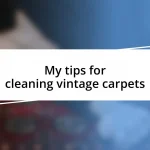Key takeaways:
- Carpets can harbor allergens such as dust mites, pet dander, and mold spores, necessitating regular cleaning to improve indoor air quality.
- Effective cleaning methods include using HEPA filter vacuums, steam cleaning, and natural remedies like essential oils and vinegar to reduce allergens.
- Preventive measures, like washing rugs, using doormats, and maintaining humidity levels, are crucial for minimizing allergen buildup and maintaining a healthy indoor environment.

Understanding carpet allergens
Carpets can be a cozy addition to any room, but they also tend to harbor a variety of allergens like dust mites, pet dander, and mold spores. I remember once pulling up a section of carpet in my living room and being shocked by how much dust floated up—it’s almost as if the carpet was hiding a little world of allergens beneath its fibers. Have you ever experienced a sneezing fit after vacuuming? That’s often a sign of the many invisible particles swirling through the air.
Understanding these allergens is crucial, especially if you or someone in your household suffers from allergies or asthma. Like many, I’ve walked into a friend’s home and instantly felt my allergies flare—it’s a vivid reminder of how carpets can trap allergens, making it essential to keep them clean. Have you noticed how some homes just seem fresher and less congested? That’s often due to regular carpet maintenance and the choice of materials.
In addition to dust and pet-related allergens, certain carpets can even contribute to poor indoor air quality through the release of volatile organic compounds (VOCs). The first time I considered this was after reading a report on flooring materials; it made me rethink my carpet choices entirely. Isn’t it fascinating how something we often overlook can have such a significant impact on our health?

Common sources of carpet allergens
Carpets can easily gather hidden allergens, making them a prime concern for anyone sensitive to indoor air quality. I once attended a gathering at a friend’s place, and the moment I stepped onto the plush carpet, I felt a dust cloud stir up, triggering my nose. The surprise and discomfort taught me just how important it is to consider the state of our carpets, especially with common allergens lurking within.
Dust mites are notorious for thriving in carpets, feeding on shed skin cells. It’s almost mind-boggling to think about how microscopic these creatures are, yet they can cause major allergic reactions. I recall a particularly bad allergy season where my carpet felt like an enemy territory. Regularly washing bedding and vacuuming helped, but initially, I didn’t realize how critical it was to target the carpets too.
Additionally, pet dander can be another significant allergen, particularly for animal lovers. If you have fur babies, like I do, you might have noticed their hair woven into the fabric of your carpets. It can feel frustrating when you think you’ve cleaned every surface, only to find your beloved pets have left their mark. That’s when I learned to rely on specialized vacuum cleaners designed for pet owners.
| Common Sources of Carpet Allergens | Impact |
|---|---|
| Dust Mites | Trigger asthma and allergy symptoms |
| Pet Dander | Causes irritation and allergic reactions |
| Mold Spores | Contributes to respiratory issues |
| Volatile Organic Compounds (VOCs) | Affects indoor air quality |

Effective cleaning methods
Keeping carpets clean is vital for reducing allergens, and I’ve discovered a few effective methods that truly make a difference. After investing time in various cleaning techniques, I’ve found that a combination of regular vacuuming and deep cleaning works wonders. I recall one particularly gloomy spring when my allergies escalated. I decided to deep clean my carpets. The improvement was palpable, lifting a weight off my chest, quite literally!
Here are some of the most effective cleaning methods I’ve tried:
- Vacuuming with a HEPA filter: This type of vacuum captures small particles better than regular ones, helping to reduce allergens significantly.
- Steam cleaning: Using hot water and steam to cleanse carpets not only removes embedded dirt but also kills dust mites and mold spores.
- Baking soda treatment: Sprinkling baking soda on carpets before vacuuming can neutralize odors and lift out dust, giving a fresher feel.
- Professional cleaning: Sometimes, bringing in the experts is the best option. I’ve found their advanced techniques and equipment tackle allergens I couldn’t manage alone.
Each of these methods has its own charm and benefits, but it’s the results you see and feel that really makes the difference. It’s amazing how a thorough cleaning can not only brighten your living space, but also lighten your mood and clear your air.

Best vacuum cleaners to use
When it comes to choosing the best vacuum cleaner for tackling carpet allergens, I always recommend looking for models equipped with a HEPA filter. These filters trap tiny particles, including dust mites and pet dander, which makes a noticeable difference in the air quality of your home. I remember when I switched to a HEPA vacuum; the first few times I used it, I couldn’t believe how much dust it extracted. It felt like I was finally taking control of my allergy management.
I also believe in the power of versatile vacuum cleaners. Those that come with specialized attachments for carpets and upholstery can be game changers. I once had a handheld vacuum that did wonders for my car and couch, but it suddenly became my best friend when tackling stubborn allergens in my carpet too. The ability to switch up the tools made cleaning less of a chore and more of an accomplishment, reminding me that every session was a step towards a healthier space.
But let’s not forget the joy of a vacuum design that suits your lifestyle. For example, if you have pets, a vacuum designed for pet hair can save you time and energy. I often find myself racing against my dog’s shedding season, and having a model that efficiently tackles fur means fewer sneeze attacks for me. Isn’t it fantastic to know that the right vacuum cleaner can turn what feels like an endless chore into a more manageable task?

Natural remedies for allergen reduction
Natural remedies can also be a great way to reduce allergens in your carpets. One method I really enjoy is using essential oils, specifically lavender and eucalyptus. A few drops mixed with water in a spray bottle can create a refreshing mist that not only smells delightful but also helps repel dust mites. I remember one time after I spritzed my carpets with this blend; it was like walking into a calming spa. The improvement in my home’s atmosphere really made me feel more relaxed.
Another natural remedy I swear by is vinegar. It’s a versatile solution, and when mixed with baking soda, it becomes a powerful deodorizer and cleaner for carpets. I still have a vivid memory of applying this mixture to a stubborn stain; the fizzing action was exciting, and the satisfaction of seeing the stain disappear brought such joy! Plus, vinegar is excellent at neutralizing odors and can help reduce the pet dander in my home, which is a major perk for anyone with furry friends.
Lastly, I have to mention the power of good old-fashioned salt. Sprinkling salt on your carpets can help draw out moisture and allergens. After a particularly rainy season, I tried this and was pleasantly surprised by the results. The next time I vacuumed, I noticed a significant difference in the dust and allergens that were expelled. Have you ever thought about how simple, everyday items can be so effective in allergy management? It makes me appreciate the little things that can lead to a fresher, healthier home.

Preventive measures for allergen buildup
Implementing preventive measures in my home has been a game changer for reducing allergen buildup. For instance, I regularly wash my carpets and rugs, which, surprisingly, makes a huge difference. I remember the first time I put my area rugs through the washing machine; the amount of dust that came out was shocking! It’s like I was reintroducing fresh air into my space.
I also prioritize keeping my windows closed during pollen season. Even though the idea of fresh air is tempting, I learned the hard way that it can invite unwanted allergens inside. There was a season when my allergies flared up out of nowhere, and it turned out I had neglected to close my windows during peak pollen days. I now keep track of pollen counts and plan my cleaning and airing out accordingly. Have you ever considered how simple environmental adjustments can significantly impact your comfort at home?
Another trick I’ve adopted is to place doormats at every entrance. This might sound simple, but it’s truly effective in trapping dirt and allergens before they even reach my carpet. After a guest left a trail of dust inside, I realized the importance of this small habit. I started asking everyone to wipe their feet, and I felt an immediate difference in my home’s cleanliness. It’s amazing how small changes can lead to a reduction in allergens and create a more enjoyable living environment.

Maintaining a healthy indoor environment
Maintaining a healthy indoor environment is crucial for anyone dealing with allergies, and I’ve found that a few consistent practices make all the difference. One of my favorite strategies is using high-efficiency particulate air (HEPA) filters in my vacuum cleaner and air purifier. The first time I swapped out my old vacuum for a HEPA model, I was astonished at the amount of dust it captured. It felt like I had been unknowingly living in a dust storm!
Another essential aspect is keeping humidity levels in check. I’ve learned through experience that allergens thrive in damp conditions, so I use a dehumidifier in the spring and summer. It’s remarkable how much a difference it makes. The air feels lighter, and my allergies are much more manageable. Have you ever thought about how humidity can sneaky sabotage your air quality? When my dehumidifier runs, I always breathe a sigh of relief knowing I’m creating a healthier space for myself and my family.
Finally, regular cleaning is non-negotiable. I set aside time each week to dust surfaces, wash curtains, and clean corners where allergens like to hide. One day, I came across an old knickknack that hadn’t seen a cloth in years, and I was shocked to discover how much dust had settled on it. That moment reminded me that even the tiniest objects can hold allergens, which motivated me to be more diligent. What habits have you adopted to keep your environment allergen-free? Every little effort counts toward creating a sanctuary free from the discomfort of pollutants.














